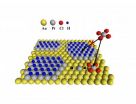(Press-News.org) A University of Oklahoma-led study has demonstrated that ancient DNA can be used to understand ancient human microbiomes. The microbiomes from ancient people have broad reaching implications for understanding recent changes to human health, such as what good bacteria might have been lost as a result of our current abundant use of antibiotics and aseptic practices.
Cecil M. Lewis Jr., professor of anthropology in the OU College of Arts and Sciences and director of the OU Molecular Anthropology Laboratory, and Raul Tito, OU Research Associate, led the research study that analyzed microbiome data from ancient human fecal samples collected from three different archaeological sites in the Americas, each dating to over 1000 years ago. In addition, the team provided a new analysis of published data from two samples that reflect rare and extraordinary preservation: Otzi the Iceman and a soldier frozen for 93 years on a glacier.
"The results support the hypothesis that ancient human gut microbiomes are more similar to those of non-human primates and rural non-western communities than to those of people living a modern lifestyle in the United States," says Lewis. "From these data, the team concluded that the last 100 years has been a time of major change to the human gut microbiome in cosmopolitan areas."
"Dietary changes, as well as the widespread adoption of various aseptic and antibiotic practices have largely benefited modern humans, but many studies suggest there has been a cost, such as a recent increase in autoimmune related risks and other health states," states Lewis.
"We wish to reveal how this co-evolutionary relationship between humans and bacteria has changed, while providing the foundation for interventions to reconstruct what has been lost. One way to do this is to study remote communities and non-human primates. An alternative path is to look at ancient samples and see what they tell us," Lewis says.
"An argument can be made that remote traditional communities are not truly removed from modern human ecologies. They may receive milk or other food sources from the government, which could alter the microbial ecology of the community. Our evolutionary cousins, non-human primates are important to consider. However, the human-chimp common ancestor was over six million years ago, which is a lot of time for microbiomes to evolve distinct, human signatures."
Retrieving ancient human microbiome data is complementary to these studies. However, studying ancient microbiomes is not without problems. Assuming DNA preserves, there is also a problem with contamination and modification of ancient samples, both from the soil deposition, and from other sources, including the laboratory itself.
"In addition to laboratory controls in our study, we use an exciting new quantitative approach called source tracking developed by Dan Knights from Rob Knight's Laboratory at the University of Colorado in Boulder, which can estimate how much of the ancient microbiome data is consistent with the human gut, rather than other sources, such as soil," explains Lewis.
"We discovered that certain samples have excellent gut microbiome signatures, opening the door for deeper analyses of the ancient human gut, including a better understanding of the ancient humans themselves, such as learning more about their disease burdens, but also learning more about what has changed in our gut today."
###
The paper, "Insights from Characterizing Extinct Human Gut Microbiomes," will be published in the journal PLOS ONE. END
OU study suggests the bacterial ecology that lives on humans has changed in the last 100 years
Insights from 'Characterizing Extinct Human Gut Microbiomes'
2012-12-13
ELSE PRESS RELEASES FROM THIS DATE:
Hospital-based neurologists worry about career burnout
2012-12-13
MAYWOOD, Il. - A survey has identified career burnout as a significant problem among neurologists who predominantly work with hospital inpatients.
Nearly 29 percent of these "neurohospitalists" said they had experienced burnout, and 45.8 percent said they were concerned about burnout but had not yet experienced it. (Burnout was defined as maintaining a schedule so burdensome as to limit the time a physician will or could spend as a neurohospitalist.)
Results were published in the December, 2012 issue of Neurology® Clinical Practice. Among the co-authors is Jose Biller, ...
Predicting risk of arrhythmias and sudden cardiac death: There's a computer model for that
2012-12-13
VIDEO:
Scientists are using "virtual hearts " to better understand risk in real-world patients. Researcher Coeli Lopes, Ph.D., University of Rochester Medical Center, assistant professor at the Aab Cardiovascular Research Institute, describes...
Click here for more information.
A computer model of the heart wall predicted risk of irregular heart rhythms and sudden cardiac death in patients, paving the way for the use of more complex cardiac models to calculate the ...
New policy brief examines impact of occupational injuries and illnesses among low-wage workers
2012-12-13
WASHINGTON, D.C.—Low-wage workers, who make up a large and growing share of the U.S. workforce, are especially vulnerable to financial hits that can result from on-the-job injuries and illnesses, according to a policy brief released today by researchers at the George Washington University School of Public Health and Health Services (SPHHS). The policy brief, "Mom's off Work 'Cause She Got Hurt: The Economic Impact of Workplace Injuries and Illnesses in the U.S.'s Growing Low-Wage Workforce," was released along with a white paper showing that such workplace injuries and ...
Time restrictions on TV advertisements ineffective in reducing youth exposure to alcohol ads
2012-12-13
Efforts to reduce underage exposure to alcohol advertising by implementing time restrictions have not worked, according to new research from the Center on Alcohol Marketing and Youth (CAMY) at the Johns Hopkins Bloomberg School of Public Health and the Dutch Institute for Alcohol Policy. The report, published in the Journal of Public Affairs, confirms what Dutch researchers had already learned in that country: time restrictions on alcohol advertising actually increase teen exposure, because companies move the advertising to late night.
In 2009, Dutch regulators sought ...
'Curiosity' can be positioned with eclipses
2012-12-13
Observations from 'Curiosity' when Mar's moon Phobos crosses in front of the sun, like in September, help us to understand exactly where the rover is on the red planet. Researchers at the Complutense University of Madrid (Spain) have developed a method for achieving precisely this.
The exact location of Curiosity on the surface of Mars is determined using data transmitted from its antennas as well as the space probes that orbit the red planet. It is very unlikely that these systems would fail but in such an eventuality there would be an alternative for determining the ...
Uncovering a flaw in drug testing for chronic anxiety disorder
2012-12-13
Pre-clinical trials — the stage at which medications or therapies are tested on animals like laboratory mice — is a crucial part of drug development. It's only then that scientists can assess benefits and side effects before a drug is administered to patients.
Now, Prof. Ilan Golani of Tel Aviv University's Department of Zoology and Sagol School for Neuroscience and his fellow researchers Prof. Yoav Benjamini of TAU's Department of Statistics and Operations Research and the Sagol School of Neuroscience, and Dr. Ehud Fonio of the Weizmann Institute are questioning the ...
UAlberta medical researchers discover new potential chemotherapy
2012-12-13
Medical researchers at the University of Alberta have discovered that knocking out a particular "partner" gene is the Achilles' heel of some cancers.
Cancer causing genes often have a partner in crime, meaning when either of the two genes is active in cancer cells, the tumour grows. The challenge for researchers has been pinpointing the genes’ “lethal partners.” Loss of one of the partners alone isn’t deadly to the cell, but if both are gotten rid of, the cancer cells are destroyed.
Faculty of Medicine & Dentistry researcher Michael Weinfeld and his collaborators, ...
New technique for minimally invasive robotic kidney cancer surgery
2012-12-13
DETROIT – Urologists at Henry Ford Hospital have developed a new technique that could make minimally invasive robotic partial nephrectomy procedures the norm, rather than the exception for kidney cancer patients. The technique spares the kidney, eliminates long hospital stays and provides better outcomes by giving the surgeon more time to perform the procedure.
Dubbed ICE for Intracorporeal Cooling and Extraction, the technique may allow more kidney cancer patients to avoid conventional open surgery – now used in the vast majority of cases – and its possible complications, ...
Regenstrief study finds that generic drugs often have incorrect safety labeling
2012-12-13
INDIANAPOLIS -- Despite U.S. Food and Drug Administration regulations requiring generic medications to carry identical warnings to those on corresponding brand-name products, a study by Regenstrief Institute researchers has found that more than two-thirds of generic drugs have safety-warning labels that differ from the equivalent brand-name drug.
The investigators reviewed 9,105 product labels for over 1,500 drugs available on DailyMed, an online repository of labeling information maintained by the FDA and the National Library of Medicine. Of the 1,040 drugs with more ...
Novel NIST process is a low-cost route to ultrathin platinum films
2012-12-13
A research group at the National Institute of Standards and Technology (NIST) has developed a relatively simple, fast and effective method of depositing uniform, ultrathin layers of platinum atoms on a surface.* The new process exploits an unexpected feature of electrodeposition of platinum—if you drive the reaction much more strongly than usual, a new reaction steps in to shuts down the metal deposition process, allowing an unprecedented level of control of the film thickness.
Platinum is a widely used industrial catalyst—in automobile catalytic converters and hydrogen ...
LAST 30 PRESS RELEASES:
University of Oklahoma researcher awarded funding to pursue AI-powered material design
Exploring how the visual system recovers following injury
Support for parents with infants at pediatric check-ups leads to better reading and math skills in elementary school
Kids’ behavioral health is a growing share of family health costs
Day & night: Cancer disrupts the brain’s natural rhythm
COVID-19 vaccination significantly reduces risk to pregnant women and baby
The role of vaccination in maternal and perinatal outcomes associated with COVID-19 in pregnancy
Mayo Clinic smartwatch system helps parents shorten and defuse children's severe tantrums early
Behavioral health spending spikes to 40% of all children’s health expenditures, nearly doubling in a decade
Digital cognitive behavioral treatment for generalized anxiety disorder
Expenditures for pediatric behavioral health care over time and estimated family financial burden
Air conditioning in nursing homes and mortality during extreme heat
The Alps to lose a record number of glaciers in the next decade
What makes a good proton conductor?
New science reporting guide published for journalists in Bulgaria
New international study reveals major survival gaps among children with cancer
New science reporting guide published for journalists in Turkey
Scientists develop a smarter mRNA therapy that knows which cells to target
Neuroanatomy-informed brain–machine hybrid intelligence for robust acoustic target detection
Eight SwRI hydrogen projects funded by ENERGYWERX
The Lundquist Institute and its start-up company Vitalex Biosciences Announces Strategic Advancement of Second-Generation fungal Vaccine VXV-01 through Phase 1 Trials under $40 Million Competitive Con
Fine particles in pollution are associated with early signs of autoimmune disease
Review article | Towards a Global Ground-Based Earth Observatory (GGBEO): Leveraging existing systems and networks
Penn and UMich create world’s smallest programmable, autonomous robots
Cleveland researchers launch first major study to address ‘hidden performance killer’ in athletes
To connect across politics, try saying what you oppose
Modulating key interaction prevents virus from entering cells
Project explores barriers to NHS career progression facing international medical graduates
Jeonbuk National University researchers explore the impact of different seasonings on the flavor perception of Doenjang soup
Two Keck Medicine of USC Hospitals named Leapfrog Top Teaching Hospitals
[Press-News.org] OU study suggests the bacterial ecology that lives on humans has changed in the last 100 yearsInsights from 'Characterizing Extinct Human Gut Microbiomes'


